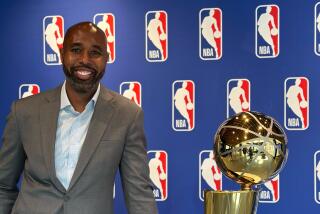This History Lesson Is Done by the Rules
- Share via
Some of the great names in basketball history were in the house, among them Kareem Abdul-Jabbar, Bill Walton and the man who mentored them at UCLA, John Wooden. None carried the weight of Naismith.
That’s Ian Naismith, grandson of the game’s inventor, James A. Naismith. And that’s 60 pounds’ worth of weight. It’s in the form of a golden briefcase that contains the typewritten pages that brought the original 13 rules of basketball to the world. Ian Naismith brought the briefcase -- chained to his wrist -- to a Basketball Hall of Fame get-together in the Beverly Hills home of Joe Smith, former Hall of Fame board member. It was a chance to establish some West Coast awareness for the hall, and perhaps pick up a couple of sponsors.
Hall of Famers Abdul-Jabbar, Walton and Ann Meyers Drysdale were there. Two of the only three people enshrined as both players and coaches were present, Wooden and Bill Sharman. (Lenny Wilkens is the third.)
More than in any other sport, the connection to basketball’s roots remains tangible. The people who popularized basketball are all around us. Of the 50 greatest players in NBA history, named in 1996, 47 are alive. You can have a moment such as last Monday’s, with the college game’s most successful coach, Wooden, chatting with the pro game’s all-time scoring leader, Abdul-Jabbar.
And no other sport offers a chance to view the game’s birth certificate.
The pages date to Dec. 21, 1891. James Naismith had spent the previous two weeks trying to devise a winter game for his physical education students at the Springfield (Mass.) YMCA who were bored with calisthenics and gymnastics. Finally, Naismith spent a sleepless night writing down 13 rules, and in the morning handed them to his secretary to type. She had 15 minutes before his class started. When she finished, Naismith pinned the two pages to a bulletin board.
Then Naismith asked the janitor to find two 18-by-20-inch boxes.
“That’s what he visualized as goals,” Ian Naismith said. “The janitor said, ‘I don’t have any boxes, but I have two peach baskets in the basement.’ That’s how it became basketball instead of boxball.”
At first it was called “Naismith Ball.” The name basketball was suggested by a student a year later, as “Basket Ball.” Another key addition after the original rules were typed: the words “into the basket” inserted after the phrase “A goal shall be made when the ball is thrown or batted from the grounds ... “
Yes, the first rules, through an oversight, lacked a clear definition of what constituted a successful attempt.
The teams were originally nine to a side because there were 18 students in the class. The baskets were 10 feet above the floor -- the measurement still used today -- because that was the height of the track circling the gym.
A student took the rules from the board and kept them in a desk drawer for years, which was fortunate because it kept the paper from fading. Then he gave them back to Naismith, who pasted them onto cardboard and held on to them for 39 years before passing them to his son, who gave them to Ian, their keeper for the last quarter century. Now they lie, side by side, sealed under a clear cover in the briefcase.
For a hoops junkie it’s a transfixing sight.
Ian (pronounced Yan) Naismith wants to get the word out, and put the documents in sight of the people. Four years ago, he started the Naismith Sportsmanship Tour, featuring the original rules and other basketball artifacts. It has made more than 30 stops around the country. Naismith, 68, doesn’t just see himself as the holder of the documents. He sees himself as a keeper of his family’s gift to the world.
He likes the state of the game now, and believes it’s a good thing that the United States no longer dominates international competition.
“People think it was an American game,” he said. “It was invented in America, but it’s worldwide.”
His grandfather was born in Canada. The game was played in China in 1893, Naismith said. And the first women’s game -- featuring James Naismith’s future wife -- was played in March 1892.
Ian Naismith can hit you with all of these facts, thanks to “40 years’ worth” of questions to his parents.
Now he spreads the word.
“The game was given to the kids of the world,” Naismith said. “It’s not to be used for egos. I don’t want to see fights. It’s not part of the game.
“I don’t care what age you are, you step on the court, you’re a role model.”
You don’t have to be James Naismith’s grandson to protect the game’s legacy. Ian Naismith just happens to do so. He had a heart attack in 1989 and a stroke a year ago, but he continues. And sometimes he sits, whether in a dome amid 50,000 fans at the NCAA Final Four, or amid the high-flying plays and hip-hop soundtrack of the NBA All-Star game, the golden briefcase tucked between his legs. And, he thinks, all of this came from the two pages inside.
“It blows my circuits,” he said.
*
J.A. Adande can be reached at [email protected]. To read previous columns by Adande, go to latimes.com/adande.
More to Read
Go beyond the scoreboard
Get the latest on L.A.'s teams in the daily Sports Report newsletter.
You may occasionally receive promotional content from the Los Angeles Times.










